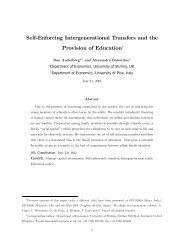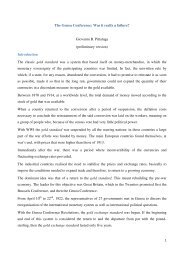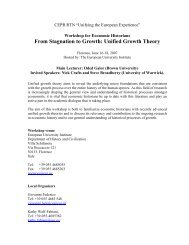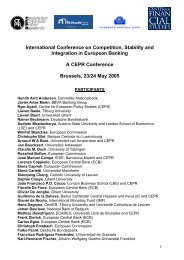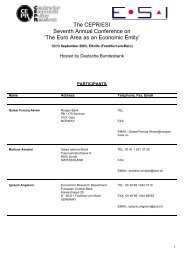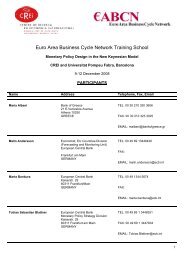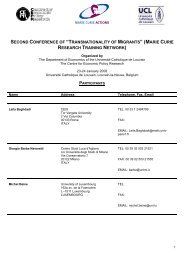MARKET STRUCTURE AND ENTRY: WHERE'S THE BEEF? - CEPR
MARKET STRUCTURE AND ENTRY: WHERE'S THE BEEF? - CEPR
MARKET STRUCTURE AND ENTRY: WHERE'S THE BEEF? - CEPR
You also want an ePaper? Increase the reach of your titles
YUMPU automatically turns print PDFs into web optimized ePapers that Google loves.
highly insignificant. In the LPM estimations, the fixed effects were jointly insignificant<br />
for both firms. To explore this issue further, we estimated restricted models to see at<br />
what level the controls for unobservables became significant. It transpired that as long as<br />
we had POP (and even when having only POP) as an explanatory variable, the random<br />
effects (fixed effects in LPM) were insignificant and very small.<br />
One possible objection is that our chosen length and timing of the empirical<br />
equivalent of the game theoretic model’s entry stage – a calendar year – is ad hoc. There<br />
are however both qualitative and quantitative reasons why a calendar year is a natural<br />
choice. For one thing, both firms are quoted companies, and necessarily report their<br />
activities (including the openings of new outlets) in published annual reports. They both<br />
also announce annual plans of new outlets to be opened. Quantitatively, we have looked<br />
at the within-calendar year timing of McD’s outlet openings which we have for a longer<br />
period. Using data from 1980 onwards (prior to 1980 the number of outlets opened was<br />
significantly smaller) it is clear that most outlets are opened towards the end of a calendar<br />
year. On average, over 30% of all outlets are opened in the month of December alone;<br />
56% are opened in the 4 th quarter; and only 5.4% in the 1 st quarter. 18 Thus there is<br />
significant evidence that the calendar year is the planning period for these firms.<br />
Then there is the issue of the sample for estimation. As mentioned in Section 3, a<br />
substantial proportion of markets has no outlets of either firm. Our estimations indicate<br />
that the most important variable (measured in terms of increasing the number of correctly<br />
predicted outcomes) is the population in a given market. Cross-tabulations reported<br />
above show that a selection rule ‘exclude all observations with population below the<br />
lowest population that has attracted an outlet by firm i’, does not reduce the sample<br />
greatly, but does lead to a significant decrease in the proportion of markets with no<br />
19



